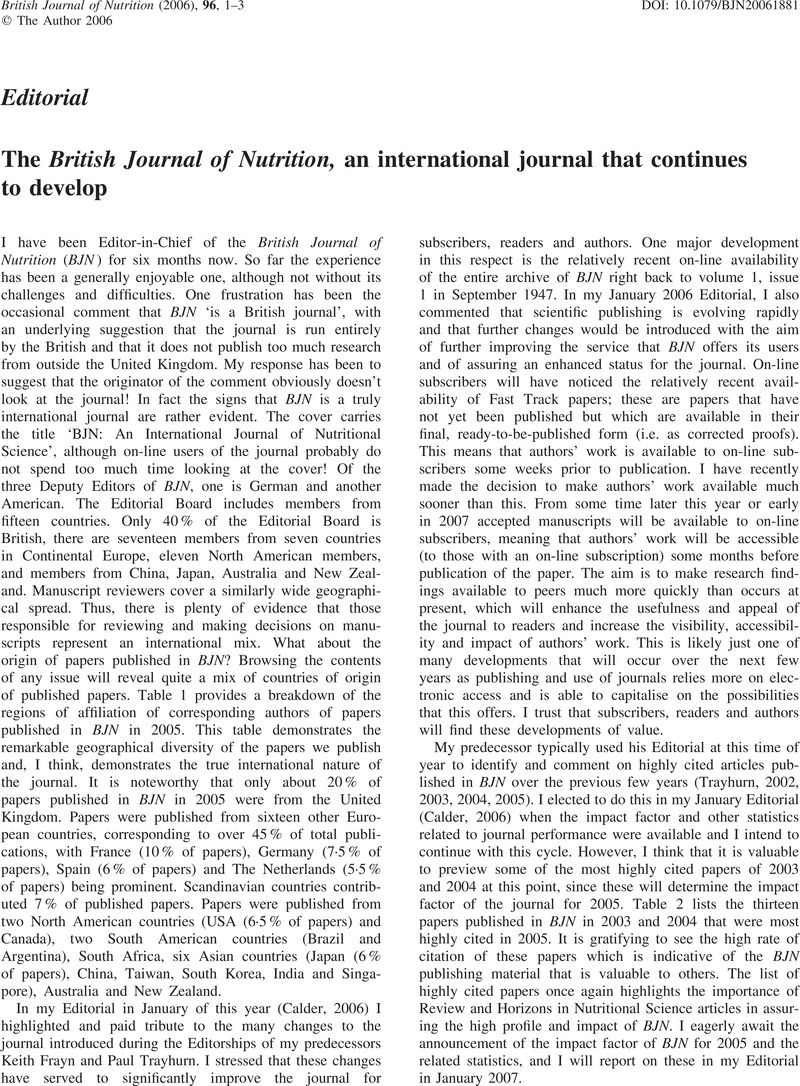Crossref Citations
This article has been cited by the following publications. This list is generated based on data provided by Crossref.
Calder, Philip C.
2007.
Happy Birthday BJN!.
British Journal of Nutrition,
Vol. 98,
Issue. 3,
p.
447.
Calder, Philip C.
2007.
Floruit floreat.
British Journal of Nutrition,
Vol. 97,
Issue. 1,
p.
1.
Blandino, Giovanna
Fazio, Davide
and
Di Marco, Roberto
2008.
Probiotics: overview of microbiological and immunological characteristics.
Expert Review of Anti-infective Therapy,
Vol. 6,
Issue. 4,
p.
497.
Finamore, Alberto
Roselli, Marianna
Britti, Serena
Monastra, Giovanni
Ambra, Roberto
Turrini, Aida
and
Mengheri, Elena
2008.
Intestinal and Peripheral Immune Response to MON810 Maize Ingestion in Weaning and Old Mice.
Journal of Agricultural and Food Chemistry,
Vol. 56,
Issue. 23,
p.
11533.
Guo, Tai L.
2008.
(Xeno)estrogen Regulation of Food Allergy.
Journal of Immunotoxicology,
Vol. 5,
Issue. 3,
p.
259.
Larbi, Anis
Combet, Emilie
Pawelec, Graham
and
Fulop, Tamas
2009.
Handbook on Immunosenescence.
p.
1437.
Pali-Schöll, Isabella
Motala, Cassim
and
Jensen-Jarolim, Erika
2009.
Asthma and Allergic Diseases in Pregnancy.
World Allergy Organization Journal,
Vol. 2,
Issue. 3,
p.
26.
Flanagan, Katie L
Burl, Sarah
Lohman-Payne, Barbara L
and
Plebanski, Magdalena
2010.
The challenge of assessing infant vaccine responses in resource-poor settings.
Expert Review of Vaccines,
Vol. 9,
Issue. 6,
p.
665.
Calder, Philip C.
2010.
Is the demographic of British Journal of Nutrition authors changing?.
British Journal of Nutrition,
Vol. 103,
Issue. 10,
p.
1389.
Benammar, Chahid
Hichami, Aziz
Yessoufou, Akadiri
Simonin, Anne-Marie
Belarbi, Meriem
Allali, Hocine
and
Khan, Naim A
2010.
Zizyphus lotus L. (Desf.) modulates antioxidant activity and human T-cell proliferation.
BMC Complementary and Alternative Medicine,
Vol. 10,
Issue. 1,
Brandtzaeg, Per
2010.
Food allergy: separating the science from the mythology.
Nature Reviews Gastroenterology & Hepatology,
Vol. 7,
Issue. 7,
p.
380.
Kussmann, Martin
2010.
Mass Spectrometry and Nutrition Research.
p.
268.
Mozurkewich, Ellen
Berman, Deborah R
and
Chilimigras, Julie
2010.
Role of omega-3 fatty acids in maternal, fetal, infant and child wellbeing.
Expert Review of Obstetrics & Gynecology,
Vol. 5,
Issue. 1,
p.
125.
Koletzko, Berthold
and
Goulet, Olivier
2010.
Fish oil containing intravenous lipid emulsions in parenteral nutrition-associated cholestatic liver disease.
Current Opinion in Clinical Nutrition and Metabolic Care,
Vol. 13,
Issue. 3,
p.
321.
Landgraf, Maristella A.
Landgraf, Richardt G.
and
Fortes, Zuleica B.
2010.
Dietary Components and Immune Function.
p.
43.
Lee, Ha-Baik
2010.
Effects of Breastfeeding on the Development of Allergies.
Hanyang Medical Reviews,
Vol. 30,
Issue. 1,
p.
49.
Cilieborg, Malene S
Boye, Mette
Mølbak, Lars
Thymann, Thomas
and
Sangild, Per T
2011.
Preterm Birth and Necrotizing Enterocolitis Alter Gut Colonization in Pigs.
Pediatric Research,
Vol. 69,
Issue. 1,
p.
10.
Riskin, Arieh
Agostoni, Carlo
and
Shamir, Raanan
2012.
Neonatology.
p.
263.
Hageman, Jeske H. J.
Hooyenga, Pieter
Diersen-Schade, Deborah A.
Scalabrin, Deolinda M. Felin
Wichers, Harry J.
and
Birch, Eileen E.
2012.
The Impact of Dietary Long-Chain Polyunsaturated Fatty Acids on Respiratory Illness in Infants and Children.
Current Allergy and Asthma Reports,
Vol. 12,
Issue. 6,
p.
564.
Pond, Caroline M.
2012.
Adipose Tissue Biology.
p.
227.





